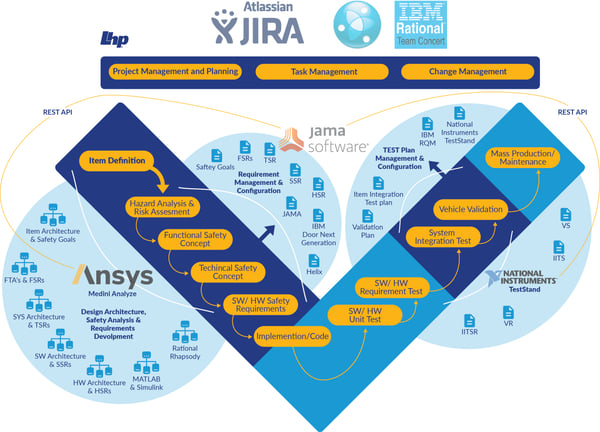Why is Safety at the Core of Software-Defined Vehicles?
Why is Safety at the Core of Software-Defined Vehicles? Creating technology can be a complicated and time-consuming process. At LHP Engineering...
Unlock Engineering Insights: Explore Our Technical Articles Now!
Discover a Wealth of Knowledge – Browse Our eBooks, Whitepapers, and More!
Stay Informed and Inspired – View Our Webinars and Videos Today!
Exploring the future of software-defined vehicles through expert insights.
4 min read
 Steve Neemeh
:
Jun 4, 2020 12:45:31 PM
Steve Neemeh
:
Jun 4, 2020 12:45:31 PM

There is a multitude of requirements management tools in the marketplace (e.g., IBM DNG, Siemens Polarion, JAMA Software, Helix). How does an organization make the important decision of which is best for its needs when the options are endless or when using Microsoft Word/Excel or Google Docs for requirements management can be considered? Is there even one tool that can meet all of the organization’s needs? This blog will describe why selecting a tool based on one specific departmental need, such as requirements management, might be impractical.
To begin the search, here are five items that might be considered:

LHP's requirements management V diagram for the Application Lifecycle Management toolchain
When researching tools for an organization, it is a common discovery that there is not one tool that meets all of the needs. The tools industry has not caught up with the complexity of the safety lifecycle. What is found in the marketplace are versions of Application Lifecycle Management (ALM) tools, but what is really needed is an LHP ecosystem-based Safety Lifecycle Management (SLM) toolchain. This SLM is based on guidelines for safety-critical development as defined in the 700+ pages of requirements, work products, and methods in standards such as ISO 26262 or the Safety of The Intended Functionality (SOTIF).
What Is the Workflow for Functional Safety, ASPICE, and Other Safety-Critical Applications?
The V diagram covers the foundational items that need to be considered in addressing a standard like ISO 26262: project management, task management, and change management. In this particular case, four tools have been considered: ANSYS Medini, JAMA Software, Atlassian JIRA, and NI (previously known as National Instruments). All four tools provide partial solutions to meeting the needs of functional safety.
By combining engineering best practices with the tools’ strengths and considering an organization’s main drivers, a workflow can be defined as one that optimizes tool usage and reduces the load on engineers. Ultimately, to be successful in safety-critical development, an organization needs to develop against a standard while also reducing the labor associated with engineering and testing.
Without the latter, the cost and time for development escalate exponentially. Are engineers going to copy and paste data across tools? Are they going to have multiple versions of the same information across different toolchains? As the complexity of systems increases, a non-optimized toolchain can paralyze an organization and its development process.
In the absence of a commercial off-the-shelf fully-compliant SLM tool, the solution of integration tools can provide the same functionality. For this purpose, the tools provide methods of connectivity with REST (Representational State Transfer) API. An example of a REST API between JAMA Software and JIRA is shown in the Appendix.
Summary
When selecting a requirements management tool, it is crucial to consider the needs of the organization as a whole, the safety workflow, and the customization and connectivity for optimization of the tools. In a typical implementation of a safety-critical system, most organizations just consider one, or parts of one, of these critical items, causing large rework and tool spending that can otherwise be avoided.
Get Started Today
Key Takeaways
Appendix: More Details About REST API
Both JAMA Software and JIRA provide access to their cloud resources via Representational State Transfer (REST) API. REST is a web-based application programming interface that exposes a set of Uniform Resource Locators (URLs) with which to carry out Create, Read, Update, and Delete (CRUD) operations in the tool. LHP Engineering Solutions has implemented a Domain Object Model (DOM) connection for both JAMA Software and JIRA with a third integration piece to connect the two. The integration piece is a configurable application that implements the customer use cases.

Benefits of Using REST API
REST API Complexities
Standard Feature Set of REST API

Why is Safety at the Core of Software-Defined Vehicles? Creating technology can be a complicated and time-consuming process. At LHP Engineering...

An Introduction to Verification and Validation Testing for ADAS

The question: When looking at functional safety, what is the difference between being ISO 26262 compliant and being ISO 26262 certified?